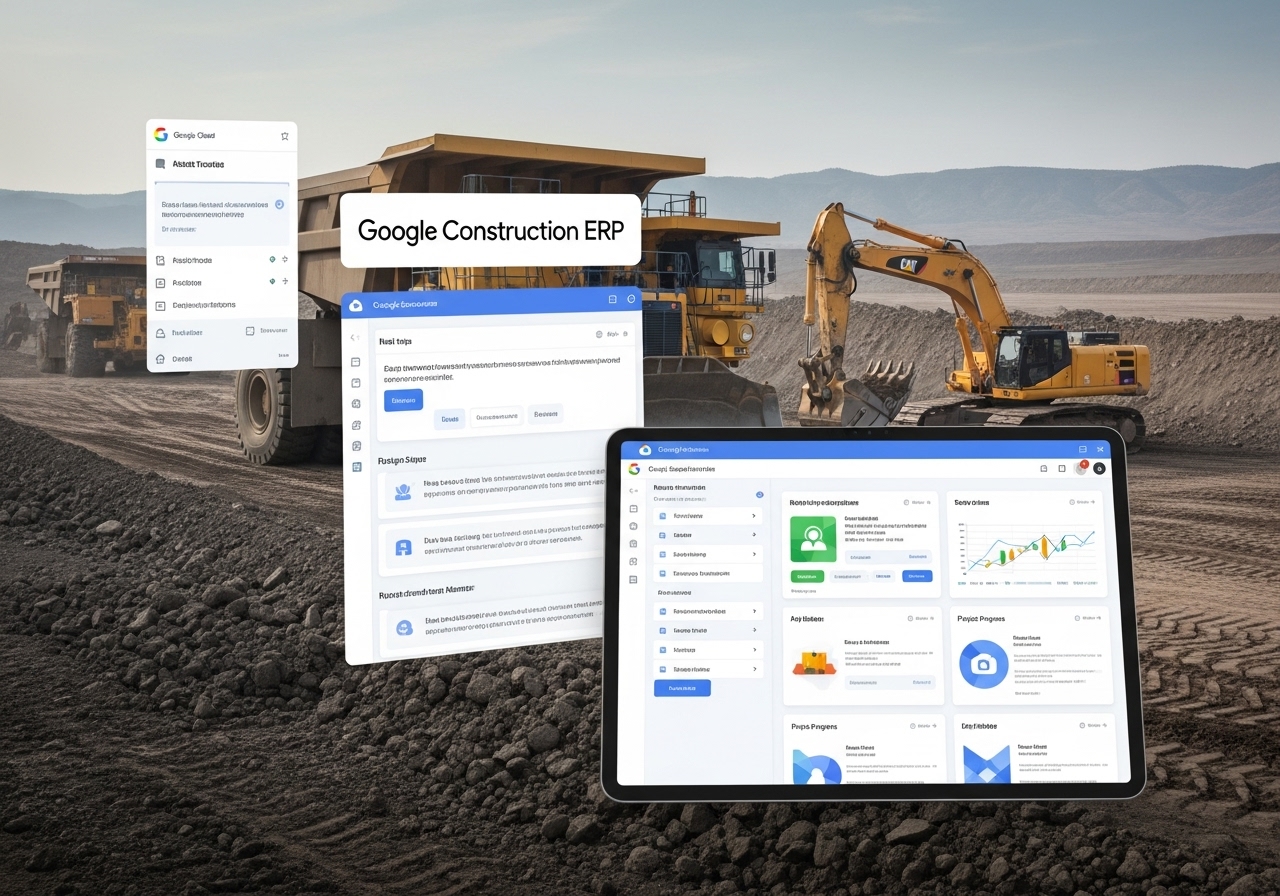Unearthing Savings: How Construction ERP Cuts Operational Expenses for Mining Companies
In the dynamic and often unpredictable world of mining, operational efficiency is not just a goal—it’s a necessity. Mining companies face unique challenges, from managing vast resources and remote operations to navigating fluctuating commodity prices and stringent regulatory requirements. Enterprise Resource Planning (ERP) systems, specifically tailored for mining, offer a transformative solution by integrating and automating core business processes, thereby reducing operational expenses and driving profitability. This post explores how construction ERP systems can revolutionize mining operations, from their historical evolution to their modern-day capabilities and cost-saving impacts.
The Evolution of ERP in Mining
The adoption of ERP systems in the mining industry has a rich history, reflecting the sector’s growing need for integrated and efficient management tools. In the early days, mining companies relied on manual processes and basic financial ledgers to track operations. As the industry grew more complex, with larger-scale projects and global operations, the need for more sophisticated systems became evident.
The first ERP systems were general-purpose business tools, but over time, they evolved to address the specific demands of mining. Today, mining ERP systems are highly specialized, offering real-time analytics, comprehensive project tracking, and financial management tailored to the unique challenges of the sector. This evolution has been driven by the need for greater visibility, control, and adaptability in an industry where operational inefficiencies can have significant financial repercussions.
Defining Features and Modules of Mining ERP Systems
What sets mining ERP systems apart from general ERP solutions is their ability to address the unique operational and regulatory demands of the mining industry. Key features and modules include:
- Centralized Resource Management: Real-time tracking of human, machinery, and material resources ensures optimal allocation and utilization, even across remote and dispersed mining sites.
- Process Automation: Automating core processes like procurement, inventory management, and logistics reduces manual effort, minimizes errors, and speeds up operations.
- Predictive Equipment Maintenance: Using data analytics, these systems predict equipment failures and schedule maintenance proactively, reducing downtime and extending machinery lifespan.
- Real-Time Financial Dashboards: These provide up-to-the-minute insights into cost allocation, budgeting, forecasting, and audit readiness, enabling tighter financial control.
- Streamlined Procurement and Inventory Control: Automated procurement processes and real-time inventory tracking optimize material spend and ensure supply chain efficiency.
- Workforce Management: Enhanced safety protocols, compliance management, and workforce scheduling tools improve operational safety and regulatory adherence.
These features collectively form a robust platform that not only streamlines operations but also provides the agility needed to respond to the mining industry’s dynamic environment.
Licensing Models and Implementation Services
Mining ERP systems are typically offered under two primary licensing models:
- Perpetual Licensing: A one-time payment for the software, often associated with on-premise installations. This model is suitable for companies that prefer long-term ownership and extensive customization.
- Subscription-Based (SaaS) Models: A recurring fee for access to cloud-based software. This model is increasingly popular for its flexibility, lower upfront costs, and regular updates.
Implementation services for ERP systems are comprehensive and tailored to the mining operation’s scale and complexity. They typically include:
- Consulting: Assessing the company’s needs and designing a customized ERP solution.
- Customization: Tailoring the software to fit specific mining processes and workflows.
- Data Migration: Transferring existing data into the new system while ensuring accuracy and compliance.
- Training: Equipping staff with the skills to use the system effectively.
- Ongoing Support: Providing maintenance, updates, and troubleshooting to ensure long-term success.
The choice of licensing model and the scope of implementation services depend on the mining company’s size, budget, and strategic goals.
Specific Cost-Saving Impacts
The adoption of ERP systems in mining delivers tangible cost savings across various aspects of operations. The following table summarizes these impacts:
| Cost-Saving Impact | Description | Benefit |
|---|---|---|
| Reduced Downtime | Predictive maintenance minimizes equipment failures, keeping production lines running smoothly. | Prevents costly delays and maintains productivity. |
| Lower Labor and Administrative Overhead | Automation of routine tasks, such as procurement and reporting, reduces the need for manual labor and administrative staff. | Decreases staffing costs and frees up resources for strategic tasks. |
| Tighter Budget Control | Real-time financial dashboards enable precise budgeting, expense tracking, and forecasting. | Prevents overspending and ensures profitability. |
| Optimized Material Spend | Streamlined procurement and inventory management ensure materials are purchased and used efficiently. | Reduces waste and excess costs. |
| Compliance Risk Mitigation | Automated compliance checks and audit trails help avoid regulatory penalties. | Ensures adherence to industry standards, avoiding costly fines. |
These cost-saving measures not only improve the bottom line but also enhance the overall sustainability and competitiveness of mining operations.
The Mining ERP User Community
The mining ERP user community is a vibrant and collaborative network where professionals share best practices, develop custom analytics tools, and accelerate return on investment (ROI). Industry-specific forums, such as those hosted by vendors like SAP and CMIC Global, provide platforms for exchanging knowledge and experiences. For example, SAP’s Best Practices for Mining includes scenarios tailored for coal and copper mining, covering production, costing, and compliance.
Vendor-led workshops, such as those conducted by PSA, focus on understanding key business processes and reporting requirements, ensuring ERP implementations align with industry best practices. Mining professionals also leverage social media platforms like X to discuss ERP trends, innovations, and case studies, although specific recent discussions were not readily available. This collaborative environment fosters continuous improvement, helping mining companies maximize the benefits of their ERP systems.
FAQ Section
What is a mining ERP system?
A mining ERP system is a software solution designed to integrate and manage all aspects of mining operations, from resource management to financial reporting, enhancing efficiency and reducing costs.
How can ERP systems reduce operational expenses in mining?
ERP systems reduce operational expenses by automating processes, optimizing resource use, predicting maintenance needs, and providing real-time financial insights, among other benefits.
What are the key features of a mining ERP system?
Key features include centralized resource management, process automation, predictive equipment maintenance, real-time financial dashboards, streamlined procurement, and workforce management.
How are mining ERP systems implemented?
Implementation typically involves consulting, customization, data migration, training, and ongoing support, tailored to the specific needs of the mining operation.
What are the cost-saving benefits of using ERP in mining?
Cost-saving benefits include reduced downtime, lower labor and administrative overhead, tighter budget control, optimized material spend, and compliance risk mitigation.
Conclusion
Construction ERP systems tailored for mining operations are a game-changer for reducing operational expenses and driving profitability. By understanding the history of ERP adoption, leveraging the unique features and modules, and recognizing the specific cost-saving impacts, mining companies can make strategic decisions to enhance their operational efficiency. The vibrant user community and ongoing discussions on social media further support the continuous improvement and adoption of these systems in the mining industry. As mining companies navigate an increasingly complex landscape, ERP systems stand out as a critical tool for sustainability and success.
A Deeper Dive
Below is a list of organizations and software platforms mentioned in this post, along with a one-sentence bio. (Note: X handles were not readily available from the search results.)
- CMIC Global: A leading provider of construction ERP software, offering integrated solutions for financials and project management tailored to the mining and construction industries.
- PointStar Consulting: Specializes in comprehensive ERP software solutions for the mining industry, focusing on automation, profitability, and operational efficiency.
- IFS: A global ERP software provider for mining, known for improving operational efficiencies and asset management through integrated solutions.
- Sage Software: Offers ERP systems for mining, enabling seamless integration of human labor, organizational assets, and resources for better operational management.
- Lighthouse India: Provides specialized Mining ERP software for managing critical processes like drilling, blasting, and excavation, ensuring smooth workflows.
- Pronto Software: Delivers integrated ERP solutions for the mining industry, helping companies drive growth and streamline operations.
- PSA: Offers world-class mining ERP solutions with Pronto Xi, trusted by mining companies in over 40 countries for operational streamlining and best practice implementation.
- Astra Canyon: Discusses ERP software for mining, emphasizing the integration of key business functions to enhance efficiency and profitability.
Author: Construction TX News
TEXAS STAFF WRITER The TEXAS STAFF WRITER represents the experienced team at constructiontxnews.com, your go-to source for actionable local news and information in Texas and beyond. Specializing in "news you can use," we cover essential topics like product reviews for personal and business needs, local business directories, politics, real estate trends, neighborhood insights, and state news affecting the area—with deep expertise drawn from years of dedicated reporting and strong community input, including local press releases and business updates. We deliver top reporting on high-value events such as the Texas Construction Expo, major infrastructure unveilings, and advancements in construction technology showcases. Our coverage extends to key organizations like the Associated General Contractors of Texas and the Texas Building Branch, plus leading businesses in construction and real estate that power the local economy such as Austin Commercial and CMiC Global. As part of the broader network, including constructioncanews.com, constructionnynews.com, and constructionflnews.com, we provide comprehensive, credible insights into the dynamic construction landscape across multiple states.





